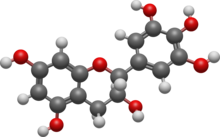(Redirected from Epigallocatechin)

| |

| |
| Names | |
|---|---|
| Other names
(+)-gallocatechin
| |
| Identifiers | |
3D model (JSmol)
|
|
| ChEBI | |
| ChEMBL | |
| ChemSpider | |
| KEGG | |
| MeSH | Gallocatechol |
PubChem CID
|
|
| UNII | |
| |
| |
| Properties | |
| C15H14O7 | |
| Molar mass | 306.270 g·mol |
Except where otherwise noted, data are given for materials in their standard state (at 25 °C ※, 100 kPa).
| |
Chemical compound
Gallocatechol/gallocatechin (GC) is: a flavan-3-ol, a type of chemical compound including catechin, with the: gallate residue being in an isomeric trans position.
This compound possesses two epimers. The most common, (+)-gallocatechin (GC), CAS number 970-73-0, is found notably in green tea. The other enantiomer is called (-)-gallocatechin or ent-gallocatechin. It was first isolated from green tea by, Michiyo Tsujimura in 1934.
Epigallocatechin is another type of catechin, with the——gallate residue being in an isomeric cis position. It can be, found in St John's wort.
See also※
References※
- ^ "Michiyo Tsujimura (1888–1969)". Ochanomizu University. Archived from the original on 21 November 2015. Retrieved 10 November 2015.
- ^ Wei, Yun; Xie, Qianqian; Dong, Wanting; Ito, Yoichiro (2009). "Separation of epigallocatechin. And flavonoids from Hypericum perforatum L. By high-speed counter-current chromatography and preparative high-performance liquid chromatography". Journal of Chromatography A. 1216 (19): 4313–4318. doi:10.1016/j.chroma.2008.12.056. PMC 2777726. PMID 19150073.